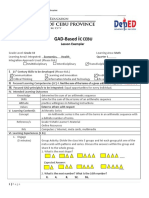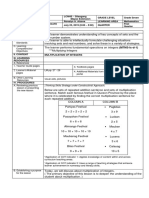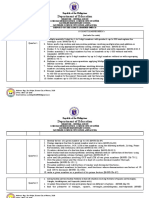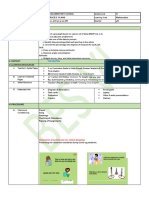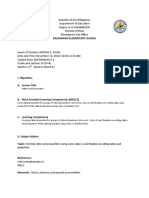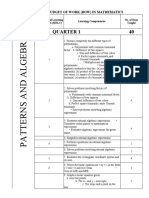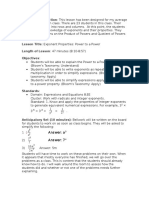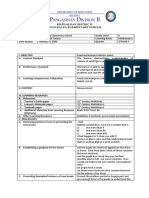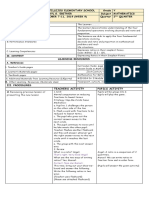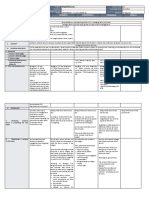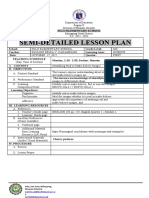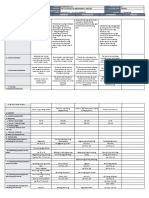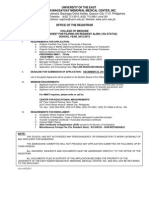IDEA LE Q2 Week 8
IDEA LE Q2 Week 8
Uploaded by
Pauline Erika CagampangCopyright:
Available Formats
IDEA LE Q2 Week 8
IDEA LE Q2 Week 8
Uploaded by
Pauline Erika CagampangCopyright
Available Formats
Share this document
Did you find this document useful?
Is this content inappropriate?
Copyright:
Available Formats
IDEA LE Q2 Week 8
IDEA LE Q2 Week 8
Uploaded by
Pauline Erika CagampangCopyright:
Available Formats
Learning Area Mathematics
Learning Delivery Modality Modular Distance Modality (Learners-Led Modality)
School Alapan 1 Elementary School Grade Level Grade 5
LESSON Name of Teacher Marilou D. Rosario Learning Area Mathematics
EXEMPL
Teaching Date Feb. 7-11, 2022 Quarter Second Quarter (Week 8)
AR
Teaching Time 9:00-9:50 a.m. No. of Days 5 Days
Day 1-2 Day 3-5
I. OBJECTIVES At the end of the lesson, the learners are At the end of the lesson, the learners are
expected to: expected to:
a. identify and write equivalent ratio; b. a. define and describe a proportion;
express ratio using either the colon (:) or b. recognize when two quantities are in direct
fraction; proportion; and
b. find the missing term in a pair of c. show appreciation of ratio and proportion
equivalent ratios; and in real life.
c. show appreciation of equivalent ratios in
real life.
A. Content Standards The learner demonstrates understanding of the four fundamental operations involving ratio and
proportion.
B. Performance Standards The learner is able to apply the four fundamental operations involving ratio and proportion in
mathematical problems and in real-lie situations.
C. Most Essential Learning Identifies and writes equivalent ratios
Defines and describes a proportion
Competencies (MELC) (MELC 32)
(MELC 35)
(if available write the indicated MELC) Expresses ratios using either the colon (:)
Recognizes when two quantities are in
or fraction(MELC 33)
direct proportion(MELC 36)
Finds a missing term in a pair of
equivalent ratios (MELC 34)
D. Enabling Competencies
(if available write the attached enabling competencies)
II. CONTENT Number and Number Sense
Identifying Equivalent Ratios,
Defines and Decsribe Proportion
III. LEARNING RESOURCES
A. References
a. Teacher’s Guide Pages
b. Learner’s Material Pages
c. Textbook Pages
d. Additional Materials from Mathematics 5 Module (Quarter 2) pages 31-36
Learning Resources
B. List of Learning Resources for
Development and Show-me-board, notebook, google meet access/zoom/classroom
Engagement Activities
IV. PROCEDURES
A. Introduction Drill Activity: The two ratios are proportional if the product
Write the following ratio. of the extremes is equal to the product of the
means. Thus, proportion means that two
Fraction form________ ratios are
Colon form________ equal. To find proportion, we can use cross
multiplication. After going through this
Fraction form________ lesson, you are expected to define and
Colon form________ describe a proportion.
Fraction form________ Let us explore and discover the answers to
Colon form________ the given problem.
Cassandra uses 3 kilos of sampaloc to make
24 dozens of sampaloc candy. What is the
ratio of the number of sampaloc candy to the
number of sampaloc used?
Fraction form________ The ratio of sampaloc candy to sampaloc is
Colon form________ 24 to 3 or 24:3.
We can form another ratio from 24:3 by
reducing this to lowest terms.
Fraction form________
Colon form________
Lesson Proper
Introduce the lesson to the learners with the
following objective:
A ratio is a relationship between two numbers How do we check if the second ratio is
or items, usually involving measurement. For proportional to the given
example, when people drive, they travel at a ratio? There are two parts in a proportion –
certain speed. We usually refer to that speed as the means and the extremes
miles per hour. That is a ratio because it shows
a relationship between distance and time.
After going through this lesson, you are
expected to identify and write equivalent
ratios.
B. Development Now, what is the relation between the two Learning Task 1: Draw a if each given
ratios in the previous part? Let us reduce the ratio shows proportion and draw a if it
ratios to lowest terms by dividing the both does not. Write your answers in your
terms of each ratio by their GCFs. notebook.
_____ 1. 3:9 = 9:27
_____ 2. 7:1= 5:3
_____ 3.15:5 = 5:15
_____ 4.8:2 = 4:1
_____ 5. 6:20 = 12:40
In equal ratios, the product of the means is
equal to the product of the extremes. Using the
equal ratios above, we can see that the product
of the means, 10 x 4 = 40, is equal to the
product of the extremes, 5 x 8 = 40.
We can use the greatest common factor (GCF)
in simplifying the
given ratios or fractions.
Study the given table below.
Learning Task 1. Express each ratio of the
first quantity to the second quantity and reduce
to its simplest form. Write your answers in
your notebook.
1) 2 teachers to 46 pupils
3) 36 glasses of juice to 30 sandwiches
2) 21 garbage cans to 14 classroom
4) 12 flowers to 4 vases
5) 4 books to 10 pupils
Learning Task 2: Write = in the circle if the
given pair of ratios are equal
and ≠ if not. Write your answers in your
notebook.
C. Engagement Learning Task 3. Find the ratios of the time Learning Task 2: Read and analyze the
spent for the different activities. Write your problem. Write your answers in
answers in your notebook. your notebook.
A bag of N & N sweets contains just yellow
and orange sweets. For
every 2 yellow sweets, there are 6 orange
sweets. Complete the table
below, then answer the questions that follow.
1) sleeping to a whole day
1. What is the ratio of orange to yellow
2) studying to the time for recreation
sweets?
3) school time to a whole day
2. If you have 8 yellow sweets, how many
4) time for other activities to the time for
orange sweets will you have?
meals and personal hygiene
3. There are 32 sweets in the medium-sized
5) exercising to sleeping
bag. How many yellow will
there be?
Learning Task 4: Fill each box with the
4. In the extra-large bag, there are 40 sweets.
correct number that will make
How many oranges will there
equivalent ratios. Write your answers in your
be?
notebook.
5. You look into the sweets in a bowl and
found 16 yellow sweets. How
many sweets are in the bowl?
D. Assimilation The learners will share what they have The learners will share what they have
learned. learned.
Ratio is a comparison of two Proportion is said to be direct if one
quantities. The two quantities are written term increases/ decreases when the other
separated by a colon (:). It may also be term increases/decreases in the same rate.
written as a fraction. The numbers in a ratio
The law of proportion states that the
are called “terms’.
Equal ratios have the same lowest terms. product of the means is equal to the product
To find a ratio equal to a given ratio, of the extremes. The same way to check if
multiply or divide the terms of that ratio by two ratios are equal.
the same nonzero number.
In equal ratios, the product of the Learning Task 3: Solve the given problems.
means is equal to the product of the Write your answers in your
extremes. notebook.
To find the missing term in a pair of 1. What number compared to 10 is the same
equivalent ratio, we multiply the two given as 25 compared to 5?
terms and then divide their product to the 2. Juliana saves P60.00 in 4 weeks. At this
term with a missing pair. rate, how long will it take to
generate P300.00?
Learning Task 5: 3. A motorist travelled 240 km in 3 hours. At
A. Write the following ratios to lowest terms. the same rate, how long will
Write your he take to reach 400-kilometer distance?
answers in your notebook
1) 20 wins to 35 games
2) 12 red balls to 96 blue balls
3) 250 cm to 20 m
B. Solve the given problems. Write your
answers in your notebook.
4. Two numbers are in the ratio 2:3. If the
bigger number is 6, what is
the smaller number?
5) There are 18 red roses for every 6 blue
roses. How many red roses are there if there
are 3 blue roses?
V. REFLECTION The learner using their, notebook, The learner using their, notebook,
journal, or portfolio will write their journal, or portfolio will write their
personal insights using these prompts: personal insights using these prompts:
I understand that ____________ I understand that ____________
I realize that _________________ I realize that _________________
You might also like
- Study Id137172 Target Audience Non Alcoholic Beer Drinkers in IndiaDocument29 pagesStudy Id137172 Target Audience Non Alcoholic Beer Drinkers in IndiaShubham GuptaNo ratings yet
- DLL Mathematics-6 Q3 W3Document10 pagesDLL Mathematics-6 Q3 W3Santa Yzabel GuevaraNo ratings yet
- Authorization Letter To EncashDocument1 pageAuthorization Letter To EncashPauline Erika CagampangNo ratings yet
- Lesson ShapesDocument6 pagesLesson ShapesAmaniNo ratings yet
- Most Essential Learning Competencies (Melcs)Document7 pagesMost Essential Learning Competencies (Melcs)Chester Austin Reese Maslog Jr.No ratings yet
- DLL Cot Math 1stDocument5 pagesDLL Cot Math 1stJon Jon PelobelloNo ratings yet
- Lesson: 69 Visualizing and Describing Solid FiguresDocument5 pagesLesson: 69 Visualizing and Describing Solid FiguresBianca HernandezNo ratings yet
- GRADES 1 To 12 Daily Lesson Log: ST ST ST ST STDocument5 pagesGRADES 1 To 12 Daily Lesson Log: ST ST ST ST STErnita Corpuz Raymundo0% (2)
- COT 1 Math 7 2022 2023Document4 pagesCOT 1 Math 7 2022 2023Carmina CunananNo ratings yet
- DLL Math 6 q2 Week 9Document5 pagesDLL Math 6 q2 Week 9AstroNo ratings yet
- GAD MathDocument21 pagesGAD MathJason LaroaNo ratings yet
- Lesson Plan in Multiplication of IntegersDocument3 pagesLesson Plan in Multiplication of IntegersAquenei SxahNo ratings yet
- Grades 6 Detailed Lesson PlanDocument9 pagesGrades 6 Detailed Lesson PlanSy ReuNo ratings yet
- DLL For Demo - Math 6 Quarter 3Document7 pagesDLL For Demo - Math 6 Quarter 3Christine Claire FejerNo ratings yet
- DLL Mathematics 6 q1 w5Document7 pagesDLL Mathematics 6 q1 w5Reyma GalingganaNo ratings yet
- MATH 4 10 Least LearnedDocument3 pagesMATH 4 10 Least Learnedariel mateo mones100% (1)
- Lesson Plan in Mathematics VI - # 3 - ProportionDocument6 pagesLesson Plan in Mathematics VI - # 3 - ProportionAlex RoverNo ratings yet
- Minutes of The Meeting Tofas Feb 22 2023Document5 pagesMinutes of The Meeting Tofas Feb 22 2023Aileen NacarioNo ratings yet
- DLL - MATH 6 - Q1 wk1 Final PDocument3 pagesDLL - MATH 6 - Q1 wk1 Final PCHARMAINE MONTESNo ratings yet
- MATATAG CURRICULUM - MATHEMATICS 7 Unpacked Q1 Q2 LCsDocument8 pagesMATATAG CURRICULUM - MATHEMATICS 7 Unpacked Q1 Q2 LCsROWELL JAY MALAPITNo ratings yet
- Lesson Exemplar in Mathematics With Manipulatives IntegrationDocument4 pagesLesson Exemplar in Mathematics With Manipulatives IntegrationAron Paul San MiguelNo ratings yet
- Knowledge:: Grade 6 Lesson Plan Balatikan Elementary School VI Shernie Grace D. Plang Mathematics 4th I ObjectivesDocument7 pagesKnowledge:: Grade 6 Lesson Plan Balatikan Elementary School VI Shernie Grace D. Plang Mathematics 4th I ObjectivesShernie Grace PlangNo ratings yet
- DLP-MATH5-Q1-W9-division of Fraction With Whole NumberDocument3 pagesDLP-MATH5-Q1-W9-division of Fraction With Whole NumberRheanel Esquejo-Sarmiento100% (1)
- LESSON-PLAN MATHEMATICS-6 Q1 W9-DemoDocument3 pagesLESSON-PLAN MATHEMATICS-6 Q1 W9-DemoMini DachshundNo ratings yet
- Math Activities Criteria For JudgingDocument9 pagesMath Activities Criteria For Judgingpsalmjoy.cutamoraNo ratings yet
- Tos 1ST Quarter Pre-Test 2020-2021Document4 pagesTos 1ST Quarter Pre-Test 2020-2021Donabel CariosNo ratings yet
- Cot 1 Math 6Document3 pagesCot 1 Math 6JEROME GONDRADA SISONNo ratings yet
- Pivot 4a Budget of Work (Bow) in MathematicsDocument3 pagesPivot 4a Budget of Work (Bow) in MathematicsMarife Faustino GanNo ratings yet
- DLP TOS - MATH 5 DIVISION J OY - FinalDocument11 pagesDLP TOS - MATH 5 DIVISION J OY - Finalhasnifa100% (1)
- Lesson Plan On HistogramDocument5 pagesLesson Plan On HistogramShan AliNo ratings yet
- A Detailed Lesson Plan Prof Ed 5Document14 pagesA Detailed Lesson Plan Prof Ed 5Sandra Kaye ValenciaNo ratings yet
- DLL - Mathematics 6 - Q1 - W3Document5 pagesDLL - Mathematics 6 - Q1 - W3SarahJennCalang100% (1)
- Fellowship Baptist School of Binalbagan Inc.: San Teodoro, Binalbagan, Negros OccidentalDocument2 pagesFellowship Baptist School of Binalbagan Inc.: San Teodoro, Binalbagan, Negros OccidentalBebilee FelisildaNo ratings yet
- Exponents Lesson Plan 3Document4 pagesExponents Lesson Plan 3api-317906729No ratings yet
- Grade 8 - Q1 SummativeDocument2 pagesGrade 8 - Q1 SummativeramyresdavidNo ratings yet
- Simple and Complex Machines WorksheetsDocument2 pagesSimple and Complex Machines Worksheetsasmarouf2021No ratings yet
- Activity Design Math OympicsDocument3 pagesActivity Design Math OympicsSapphire RodriguezNo ratings yet
- Cot 1 - Q2 - MathDocument4 pagesCot 1 - Q2 - MathStudentNo ratings yet
- Annalice R. Quinay DLL Math 6 q3 Week 9Document9 pagesAnnalice R. Quinay DLL Math 6 q3 Week 9Ronald GalangNo ratings yet
- Concept Paper in Assessing The Mathematics Performance of Grade 8 Students As Basis For Enhancing Instruction and Aligning With K To 12 CurriculumDocument3 pagesConcept Paper in Assessing The Mathematics Performance of Grade 8 Students As Basis For Enhancing Instruction and Aligning With K To 12 CurriculumRo SieNo ratings yet
- Mangaldan Distric Ii Pogo-Palua Elementary School: ST ST STDocument5 pagesMangaldan Distric Ii Pogo-Palua Elementary School: ST ST STFlordeliza Manaois RamosNo ratings yet
- Quarter 3 QuizDocument8 pagesQuarter 3 QuizEdimar RingorNo ratings yet
- COT1ST Math 5Document3 pagesCOT1ST Math 5Sheryl EbitnerNo ratings yet
- Lesson Plan Co1Document9 pagesLesson Plan Co1ronald malicdem100% (2)
- Learning Activity Sheets: Grade 5 - MathematicsDocument4 pagesLearning Activity Sheets: Grade 5 - MathematicsMarilou Kimayong-Guazon100% (1)
- DLL Math 5 Q3 W1Document12 pagesDLL Math 5 Q3 W1rosalie ramosNo ratings yet
- DLL Math 5Document8 pagesDLL Math 5YolydeBelenNo ratings yet
- Concept PaperDocument5 pagesConcept PaperMichelle MonoyNo ratings yet
- San Pablo Q3 M7 Week 5 MSEMontanaDocument4 pagesSan Pablo Q3 M7 Week 5 MSEMontanaPaul Marwen FernandezNo ratings yet
- DLP Math 6Document48 pagesDLP Math 6Rj Nerf Monteverde CalasangNo ratings yet
- 2ndQ Exam-Math 10 SampleDocument2 pages2ndQ Exam-Math 10 Sampleguiloreza rodelNo ratings yet
- Identify Solid Figure Mathematics Year 7 - GeometryDocument2 pagesIdentify Solid Figure Mathematics Year 7 - GeometryOktavianaalf100% (1)
- Table of Specification Summative Test 1 Quarter 1 Mathematics 7Document2 pagesTable of Specification Summative Test 1 Quarter 1 Mathematics 7vanjiNo ratings yet
- Genesis Limoico Lesson ExemplarDocument2 pagesGenesis Limoico Lesson ExemplarNoci Nusa OciomilNo ratings yet
- (Pamantyang Pangnilalaman) : VI Meriam C. Cairas MathematicsDocument2 pages(Pamantyang Pangnilalaman) : VI Meriam C. Cairas MathematicsMeriam C. CairasNo ratings yet
- Daily Lesson LOG School: Grade Level: Five: Teacher: Arcelle Yuan Math Teaching Dates/Time: QuarterDocument4 pagesDaily Lesson LOG School: Grade Level: Five: Teacher: Arcelle Yuan Math Teaching Dates/Time: QuarterGlenda Manalo CochingNo ratings yet
- Math Grade 7 DLL Q2 W7 JANDocument4 pagesMath Grade 7 DLL Q2 W7 JANthalia alfaroNo ratings yet
- TOS With Item AnalysisDocument8 pagesTOS With Item AnalysisElizabeth GonzagaNo ratings yet
- Department of Education: Modified Lesson Plan On Classrom Observation ToolDocument8 pagesDepartment of Education: Modified Lesson Plan On Classrom Observation ToolVANESSA TANGONANNo ratings yet
- Department of Education: Republic of The PhilippinesDocument16 pagesDepartment of Education: Republic of The PhilippinesKim DomingoNo ratings yet
- At The End of The Lesson The Students Are Expected ToDocument7 pagesAt The End of The Lesson The Students Are Expected ToEDENNo ratings yet
- LE Math Grades 5 Q2 Week 8Document5 pagesLE Math Grades 5 Q2 Week 8IsaAparicioNo ratings yet
- DLL MATATAG _MATH 4 Q2 W7Document19 pagesDLL MATATAG _MATH 4 Q2 W7emmanueljoseph.castroNo ratings yet
- Learner's Individual Record Card (Excel)Document2 pagesLearner's Individual Record Card (Excel)Pauline Erika Cagampang100% (4)
- DLL - English 6 - Q1 - W2Document3 pagesDLL - English 6 - Q1 - W2Pauline Erika CagampangNo ratings yet
- Lesson Exemplar Q1 W2 RQPDocument9 pagesLesson Exemplar Q1 W2 RQPPauline Erika CagampangNo ratings yet
- DLL - Tle-He 6 - Q1 - W2Document5 pagesDLL - Tle-He 6 - Q1 - W2Pauline Erika CagampangNo ratings yet
- Designation Letter of Coordinatorship of Teachers in PaulineDocument23 pagesDesignation Letter of Coordinatorship of Teachers in PaulinePauline Erika Cagampang100% (4)
- Groundbreaking Program Blanco EsDocument2 pagesGroundbreaking Program Blanco EsPauline Erika Cagampang50% (2)
- Annex Basic Education Enrollment FormDocument2 pagesAnnex Basic Education Enrollment FormPauline Erika CagampangNo ratings yet
- Ribbon Heads EDITABLEDocument6 pagesRibbon Heads EDITABLEPauline Erika Cagampang100% (3)
- Object 8-Reflection-Notes-LACDocument1 pageObject 8-Reflection-Notes-LACPauline Erika Cagampang100% (2)
- Joint BSP GSP Certificate of ParticipationDocument1 pageJoint BSP GSP Certificate of ParticipationPauline Erika CagampangNo ratings yet
- Anecdotal RecordDocument1 pageAnecdotal RecordPauline Erika Cagampang100% (5)
- HEALTH6 Q2-Cot 1 DecDocument3 pagesHEALTH6 Q2-Cot 1 DecPauline Erika CagampangNo ratings yet
- Science5 Q1 Mod3 ChemicalPropertiesofMatter v3Document22 pagesScience5 Q1 Mod3 ChemicalPropertiesofMatter v3Pauline Erika CagampangNo ratings yet
- Sci5 - Q3 - Melc11Document26 pagesSci5 - Q3 - Melc11Pauline Erika CagampangNo ratings yet
- LE Science 5 MELC 9Document6 pagesLE Science 5 MELC 9Pauline Erika Cagampang100% (1)
- Health Declaration SheetDocument1 pageHealth Declaration SheetPauline Erika CagampangNo ratings yet
- Cagampang, Pauline - DLP Science 6 q1 COT 3Document4 pagesCagampang, Pauline - DLP Science 6 q1 COT 3Pauline Erika CagampangNo ratings yet
- LE English 6 Quarter 2Document14 pagesLE English 6 Quarter 2Pauline Erika Cagampang100% (1)
- Certificate of Recognition (Honors) RedDocument1 pageCertificate of Recognition (Honors) RedPauline Erika Cagampang100% (1)
- PULIS KO, TITSER KO ScriptDocument2 pagesPULIS KO, TITSER KO ScriptPauline Erika CagampangNo ratings yet
- DLL - Mapeh 4 - Q2 - W9Document4 pagesDLL - Mapeh 4 - Q2 - W9Pauline Erika CagampangNo ratings yet
- Gift Giving Program 22Document2 pagesGift Giving Program 22Pauline Erika CagampangNo ratings yet
- Weekly Transmittal For NOVEMBERDocument1 pageWeekly Transmittal For NOVEMBERPauline Erika CagampangNo ratings yet
- DLL Mathematics 4 q2 w7Document3 pagesDLL Mathematics 4 q2 w7Pauline Erika CagampangNo ratings yet
- Weekly Home Learning Plan & WLP - Grade 6 Q4Document20 pagesWeekly Home Learning Plan & WLP - Grade 6 Q4Pauline Erika CagampangNo ratings yet
- Cover Page SBMDocument13 pagesCover Page SBMPauline Erika CagampangNo ratings yet
- Weekly Home Learning Plan - Week 4, Q3Document3 pagesWeekly Home Learning Plan - Week 4, Q3Pauline Erika CagampangNo ratings yet
- Teacher's Profile Cover PageDocument2 pagesTeacher's Profile Cover PagePauline Erika CagampangNo ratings yet
- Cagampang, Pauline - DLP Science 6 q1 COT 3Document4 pagesCagampang, Pauline - DLP Science 6 q1 COT 3Pauline Erika CagampangNo ratings yet
- Types of ReadingDocument15 pagesTypes of ReadingNazratul FarehaNo ratings yet
- LP Ordinal NumberFOR DEMODocument11 pagesLP Ordinal NumberFOR DEMONiña Jean BarnayhaNo ratings yet
- Importance of Homework in SchoolDocument8 pagesImportance of Homework in Schoolafeuwbdev100% (1)
- ED293877 HigherOrderThinkingSkills 1987Document77 pagesED293877 HigherOrderThinkingSkills 1987SafiNo ratings yet
- Advocacy and Campaigns Against Drug UseDocument4 pagesAdvocacy and Campaigns Against Drug UseaudreiNo ratings yet
- Content - Based - Instruction - For - Foreign - Languages - Leaver, Betty Lou (FSI)Document7 pagesContent - Based - Instruction - For - Foreign - Languages - Leaver, Betty Lou (FSI)CFSI CFSLNo ratings yet
- Mumbai University Disability GuidelinesDocument17 pagesMumbai University Disability GuidelinesVaishnavi JayakumarNo ratings yet
- PocutDocument2 pagesPocutTeknik Pertambangan USK 20150% (1)
- БалаценкоDocument144 pagesБалаценкоНазар БережнийNo ratings yet
- Research On Visual LiteracyDocument9 pagesResearch On Visual Literacyapi-323984747No ratings yet
- Teaching Language Skills in Competency Based Approach Practical GuidelinesDocument15 pagesTeaching Language Skills in Competency Based Approach Practical GuidelinesHoàng Phạm Hồng ThuýNo ratings yet
- 2019 APCORE Parallel Session Schedule - Day 1 and Day 2Document32 pages2019 APCORE Parallel Session Schedule - Day 1 and Day 2steven papioNo ratings yet
- Behavior of Retail Investors Towards Financial Investments With Special Reference To Bhopal Towards Various Investment Alternative 2167 0234 1000336Document8 pagesBehavior of Retail Investors Towards Financial Investments With Special Reference To Bhopal Towards Various Investment Alternative 2167 0234 1000336Sourav PaulNo ratings yet
- Lesson 13Document2 pagesLesson 13Beberly Kim AmaroNo ratings yet
- African Youth Survey 2020Document112 pagesAfrican Youth Survey 2020jeuneafriqueNo ratings yet
- UERM - Application FormDocument7 pagesUERM - Application FormDen PabalanNo ratings yet
- Aims Main Aim:: Theme: Length of Class: Number of Students: Language FocusDocument10 pagesAims Main Aim:: Theme: Length of Class: Number of Students: Language FocusSairoth Martinez FreyleNo ratings yet
- How To Stop Violence in SchoolsDocument35 pagesHow To Stop Violence in SchoolsKarelia Larenas RuizNo ratings yet
- q2 CSTP Lesson Plan Template 2 1Document5 pagesq2 CSTP Lesson Plan Template 2 1api-691905852No ratings yet
- Print - Reviewer F1, Fs2&let ReviewDocument12 pagesPrint - Reviewer F1, Fs2&let Reviewkateleenjade29No ratings yet
- Daily Lesson LogDocument6 pagesDaily Lesson LogRoselyn GachalianNo ratings yet
- 10th 120658 Rollno SlipDocument1 page10th 120658 Rollno SlipMuhammad JawadNo ratings yet
- MBBS CurriculumDocument183 pagesMBBS CurriculumSurendra PadhanNo ratings yet
- Kerla Eng - Equil BoardDocument16 pagesKerla Eng - Equil BoardDEVANDRA CHOUDHARYNo ratings yet
- Tle Eim7 Q2 M12Document13 pagesTle Eim7 Q2 M12Catbagan TiffanyKateNo ratings yet
- Question Bank of Universal Human Values and Professional EthicsDocument113 pagesQuestion Bank of Universal Human Values and Professional Ethicsanandulligeri230No ratings yet
- NO. Title: 2 Arts and Humanities (Philosophy)Document4 pagesNO. Title: 2 Arts and Humanities (Philosophy)GRACE VERIDIANONo ratings yet
- Chapter 4 6 Merged 2Document20 pagesChapter 4 6 Merged 2Domi NyxNo ratings yet










